Urban Planning: Melbourne's Planning Controls, Zones, and Heritage
VerifiedAdded on 2023/06/10
|8
|2448
|491
Essay
AI Summary
This essay provides an overview of urban planning in Melbourne, examining the planning controls currently in place, specifically focusing on 230 Alexandra Parade, Fitzroy, Vic 3065, and justifying its zone and overlay designations. It details the process for amending planning policies and explores the recognition and protection of indigenous heritage and cultural understandings within the planning framework. The essay also discusses the importance of involving indigenous people in land utilization discussions and bridging the gap between policy and practice for effective heritage preservation. The 'people-centered approach' in cultural heritage management is also highlighted, referencing the Endorois case to emphasize the significance of indigenous rights awareness in heritage land preservation. The document is available on Desklib, a platform offering AI-based study tools and solved assignments.
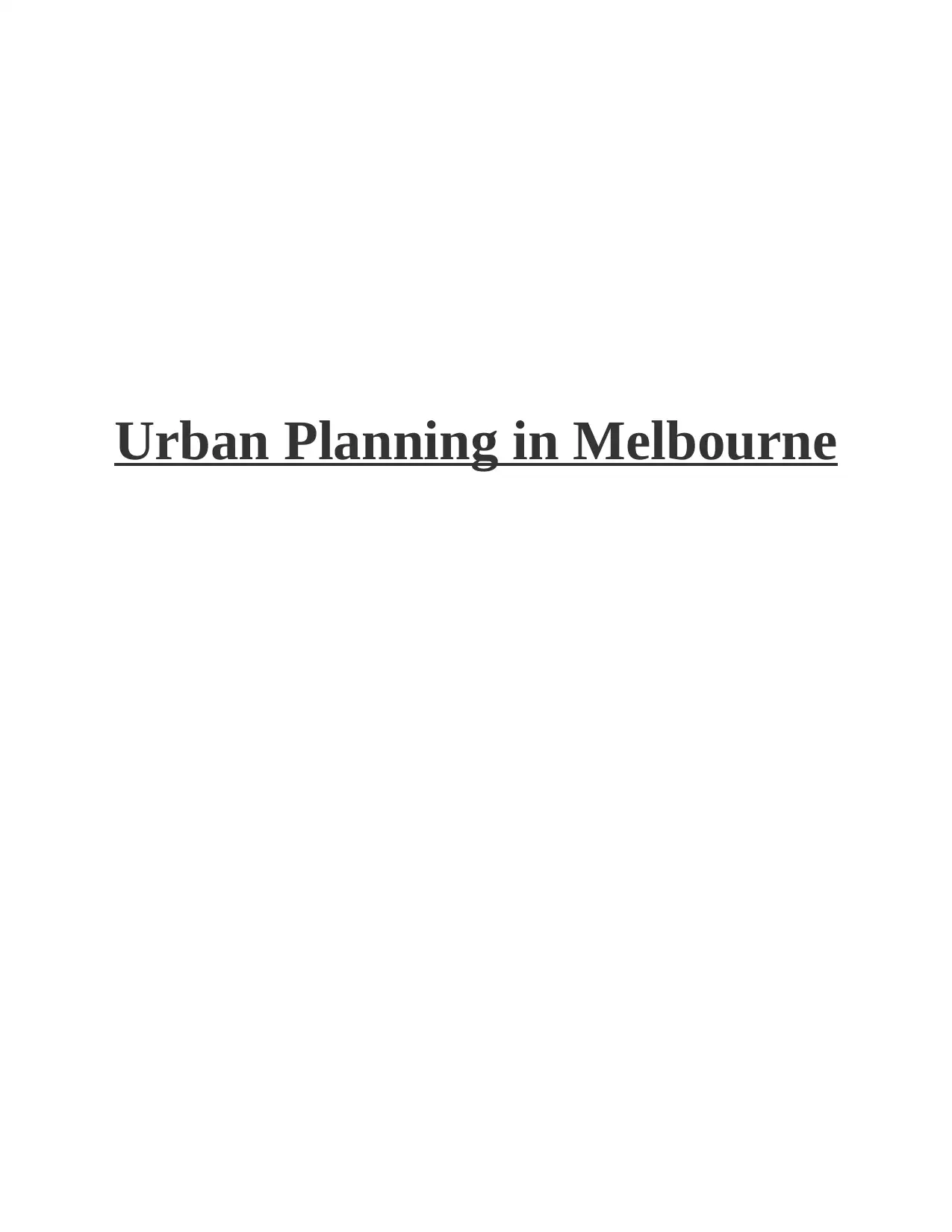
Urban Planning in Melbourne
Paraphrase This Document
Need a fresh take? Get an instant paraphrase of this document with our AI Paraphraser
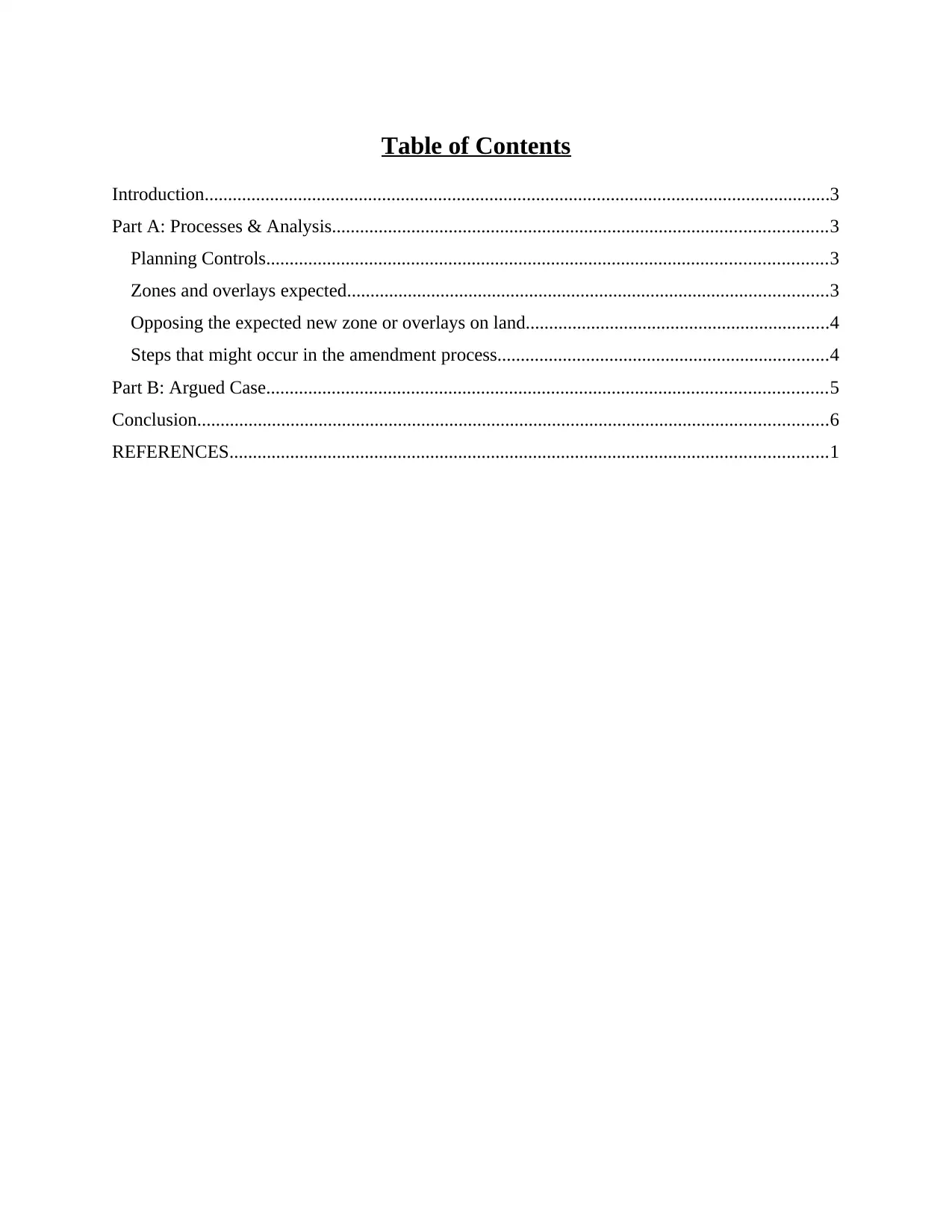
Table of Contents
Introduction......................................................................................................................................3
Part A: Processes & Analysis..........................................................................................................3
Planning Controls........................................................................................................................3
Zones and overlays expected.......................................................................................................3
Opposing the expected new zone or overlays on land.................................................................4
Steps that might occur in the amendment process.......................................................................4
Part B: Argued Case........................................................................................................................5
Conclusion.......................................................................................................................................6
REFERENCES................................................................................................................................1
Introduction......................................................................................................................................3
Part A: Processes & Analysis..........................................................................................................3
Planning Controls........................................................................................................................3
Zones and overlays expected.......................................................................................................3
Opposing the expected new zone or overlays on land.................................................................4
Steps that might occur in the amendment process.......................................................................4
Part B: Argued Case........................................................................................................................5
Conclusion.......................................................................................................................................6
REFERENCES................................................................................................................................1
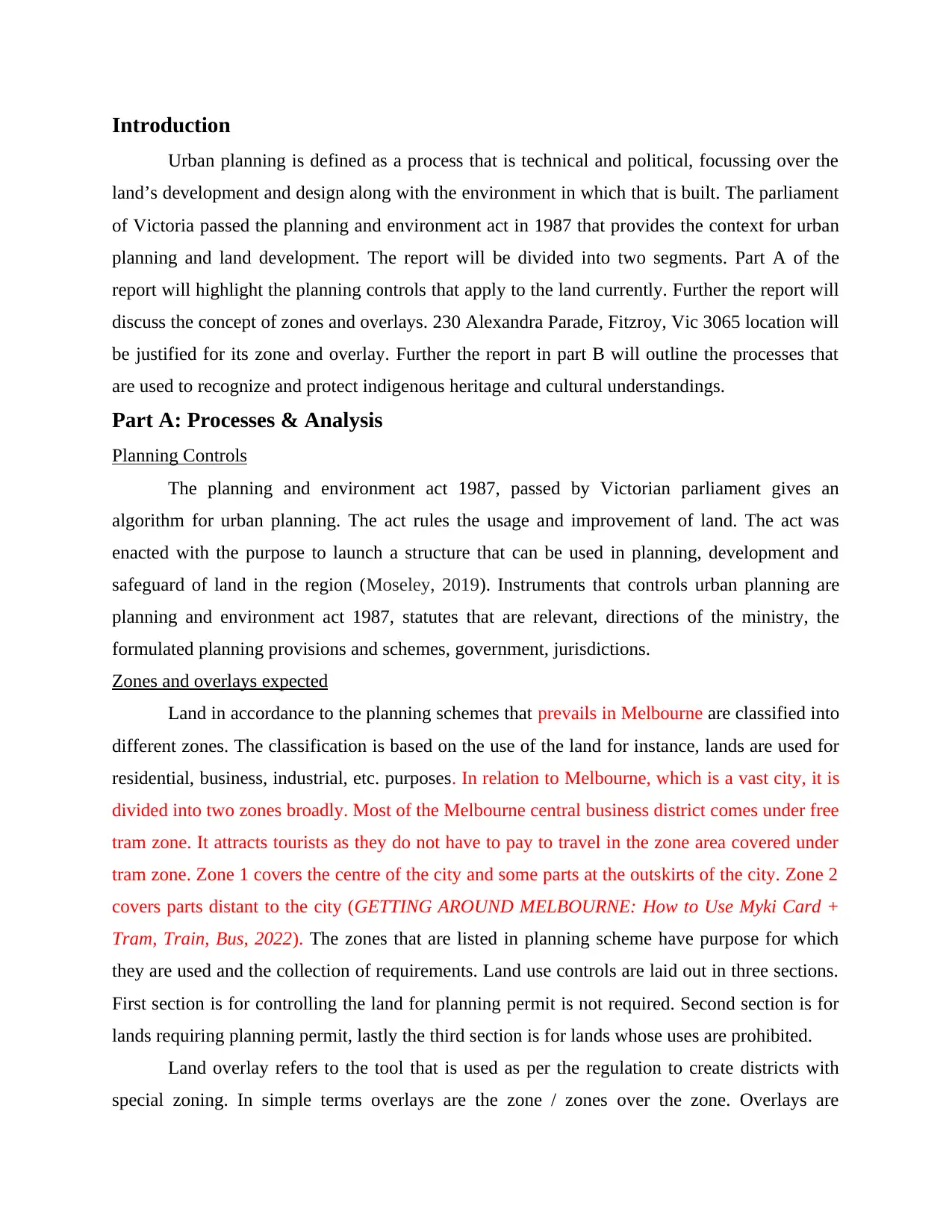
Introduction
Urban planning is defined as a process that is technical and political, focussing over the
land’s development and design along with the environment in which that is built. The parliament
of Victoria passed the planning and environment act in 1987 that provides the context for urban
planning and land development. The report will be divided into two segments. Part A of the
report will highlight the planning controls that apply to the land currently. Further the report will
discuss the concept of zones and overlays. 230 Alexandra Parade, Fitzroy, Vic 3065 location will
be justified for its zone and overlay. Further the report in part B will outline the processes that
are used to recognize and protect indigenous heritage and cultural understandings.
Part A: Processes & Analysis
Planning Controls
The planning and environment act 1987, passed by Victorian parliament gives an
algorithm for urban planning. The act rules the usage and improvement of land. The act was
enacted with the purpose to launch a structure that can be used in planning, development and
safeguard of land in the region (Moseley, 2019). Instruments that controls urban planning are
planning and environment act 1987, statutes that are relevant, directions of the ministry, the
formulated planning provisions and schemes, government, jurisdictions.
Zones and overlays expected
Land in accordance to the planning schemes that prevails in Melbourne are classified into
different zones. The classification is based on the use of the land for instance, lands are used for
residential, business, industrial, etc. purposes. In relation to Melbourne, which is a vast city, it is
divided into two zones broadly. Most of the Melbourne central business district comes under free
tram zone. It attracts tourists as they do not have to pay to travel in the zone area covered under
tram zone. Zone 1 covers the centre of the city and some parts at the outskirts of the city. Zone 2
covers parts distant to the city (GETTING AROUND MELBOURNE: How to Use Myki Card +
Tram, Train, Bus, 2022). The zones that are listed in planning scheme have purpose for which
they are used and the collection of requirements. Land use controls are laid out in three sections.
First section is for controlling the land for planning permit is not required. Second section is for
lands requiring planning permit, lastly the third section is for lands whose uses are prohibited.
Land overlay refers to the tool that is used as per the regulation to create districts with
special zoning. In simple terms overlays are the zone / zones over the zone. Overlays are
Urban planning is defined as a process that is technical and political, focussing over the
land’s development and design along with the environment in which that is built. The parliament
of Victoria passed the planning and environment act in 1987 that provides the context for urban
planning and land development. The report will be divided into two segments. Part A of the
report will highlight the planning controls that apply to the land currently. Further the report will
discuss the concept of zones and overlays. 230 Alexandra Parade, Fitzroy, Vic 3065 location will
be justified for its zone and overlay. Further the report in part B will outline the processes that
are used to recognize and protect indigenous heritage and cultural understandings.
Part A: Processes & Analysis
Planning Controls
The planning and environment act 1987, passed by Victorian parliament gives an
algorithm for urban planning. The act rules the usage and improvement of land. The act was
enacted with the purpose to launch a structure that can be used in planning, development and
safeguard of land in the region (Moseley, 2019). Instruments that controls urban planning are
planning and environment act 1987, statutes that are relevant, directions of the ministry, the
formulated planning provisions and schemes, government, jurisdictions.
Zones and overlays expected
Land in accordance to the planning schemes that prevails in Melbourne are classified into
different zones. The classification is based on the use of the land for instance, lands are used for
residential, business, industrial, etc. purposes. In relation to Melbourne, which is a vast city, it is
divided into two zones broadly. Most of the Melbourne central business district comes under free
tram zone. It attracts tourists as they do not have to pay to travel in the zone area covered under
tram zone. Zone 1 covers the centre of the city and some parts at the outskirts of the city. Zone 2
covers parts distant to the city (GETTING AROUND MELBOURNE: How to Use Myki Card +
Tram, Train, Bus, 2022). The zones that are listed in planning scheme have purpose for which
they are used and the collection of requirements. Land use controls are laid out in three sections.
First section is for controlling the land for planning permit is not required. Second section is for
lands requiring planning permit, lastly the third section is for lands whose uses are prohibited.
Land overlay refers to the tool that is used as per the regulation to create districts with
special zoning. In simple terms overlays are the zone / zones over the zone. Overlays are
⊘ This is a preview!⊘
Do you want full access?
Subscribe today to unlock all pages.

Trusted by 1+ million students worldwide
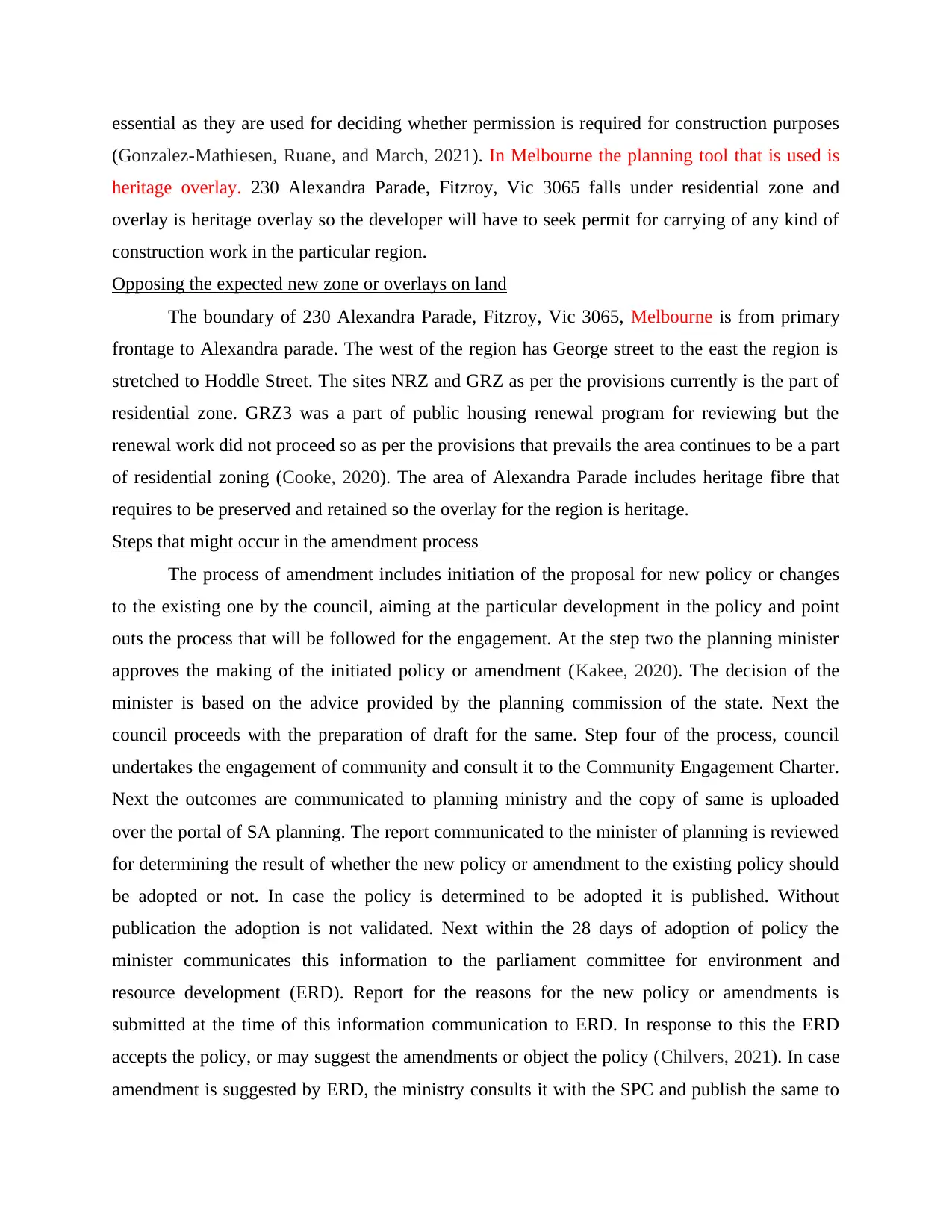
essential as they are used for deciding whether permission is required for construction purposes
(Gonzalez-Mathiesen, Ruane, and March, 2021). In Melbourne the planning tool that is used is
heritage overlay. 230 Alexandra Parade, Fitzroy, Vic 3065 falls under residential zone and
overlay is heritage overlay so the developer will have to seek permit for carrying of any kind of
construction work in the particular region.
Opposing the expected new zone or overlays on land
The boundary of 230 Alexandra Parade, Fitzroy, Vic 3065, Melbourne is from primary
frontage to Alexandra parade. The west of the region has George street to the east the region is
stretched to Hoddle Street. The sites NRZ and GRZ as per the provisions currently is the part of
residential zone. GRZ3 was a part of public housing renewal program for reviewing but the
renewal work did not proceed so as per the provisions that prevails the area continues to be a part
of residential zoning (Cooke, 2020). The area of Alexandra Parade includes heritage fibre that
requires to be preserved and retained so the overlay for the region is heritage.
Steps that might occur in the amendment process
The process of amendment includes initiation of the proposal for new policy or changes
to the existing one by the council, aiming at the particular development in the policy and point
outs the process that will be followed for the engagement. At the step two the planning minister
approves the making of the initiated policy or amendment (Kakee, 2020). The decision of the
minister is based on the advice provided by the planning commission of the state. Next the
council proceeds with the preparation of draft for the same. Step four of the process, council
undertakes the engagement of community and consult it to the Community Engagement Charter.
Next the outcomes are communicated to planning ministry and the copy of same is uploaded
over the portal of SA planning. The report communicated to the minister of planning is reviewed
for determining the result of whether the new policy or amendment to the existing policy should
be adopted or not. In case the policy is determined to be adopted it is published. Without
publication the adoption is not validated. Next within the 28 days of adoption of policy the
minister communicates this information to the parliament committee for environment and
resource development (ERD). Report for the reasons for the new policy or amendments is
submitted at the time of this information communication to ERD. In response to this the ERD
accepts the policy, or may suggest the amendments or object the policy (Chilvers, 2021). In case
amendment is suggested by ERD, the ministry consults it with the SPC and publish the same to
(Gonzalez-Mathiesen, Ruane, and March, 2021). In Melbourne the planning tool that is used is
heritage overlay. 230 Alexandra Parade, Fitzroy, Vic 3065 falls under residential zone and
overlay is heritage overlay so the developer will have to seek permit for carrying of any kind of
construction work in the particular region.
Opposing the expected new zone or overlays on land
The boundary of 230 Alexandra Parade, Fitzroy, Vic 3065, Melbourne is from primary
frontage to Alexandra parade. The west of the region has George street to the east the region is
stretched to Hoddle Street. The sites NRZ and GRZ as per the provisions currently is the part of
residential zone. GRZ3 was a part of public housing renewal program for reviewing but the
renewal work did not proceed so as per the provisions that prevails the area continues to be a part
of residential zoning (Cooke, 2020). The area of Alexandra Parade includes heritage fibre that
requires to be preserved and retained so the overlay for the region is heritage.
Steps that might occur in the amendment process
The process of amendment includes initiation of the proposal for new policy or changes
to the existing one by the council, aiming at the particular development in the policy and point
outs the process that will be followed for the engagement. At the step two the planning minister
approves the making of the initiated policy or amendment (Kakee, 2020). The decision of the
minister is based on the advice provided by the planning commission of the state. Next the
council proceeds with the preparation of draft for the same. Step four of the process, council
undertakes the engagement of community and consult it to the Community Engagement Charter.
Next the outcomes are communicated to planning ministry and the copy of same is uploaded
over the portal of SA planning. The report communicated to the minister of planning is reviewed
for determining the result of whether the new policy or amendment to the existing policy should
be adopted or not. In case the policy is determined to be adopted it is published. Without
publication the adoption is not validated. Next within the 28 days of adoption of policy the
minister communicates this information to the parliament committee for environment and
resource development (ERD). Report for the reasons for the new policy or amendments is
submitted at the time of this information communication to ERD. In response to this the ERD
accepts the policy, or may suggest the amendments or object the policy (Chilvers, 2021). In case
amendment is suggested by ERD, the ministry consults it with the SPC and publish the same to
Paraphrase This Document
Need a fresh take? Get an instant paraphrase of this document with our AI Paraphraser
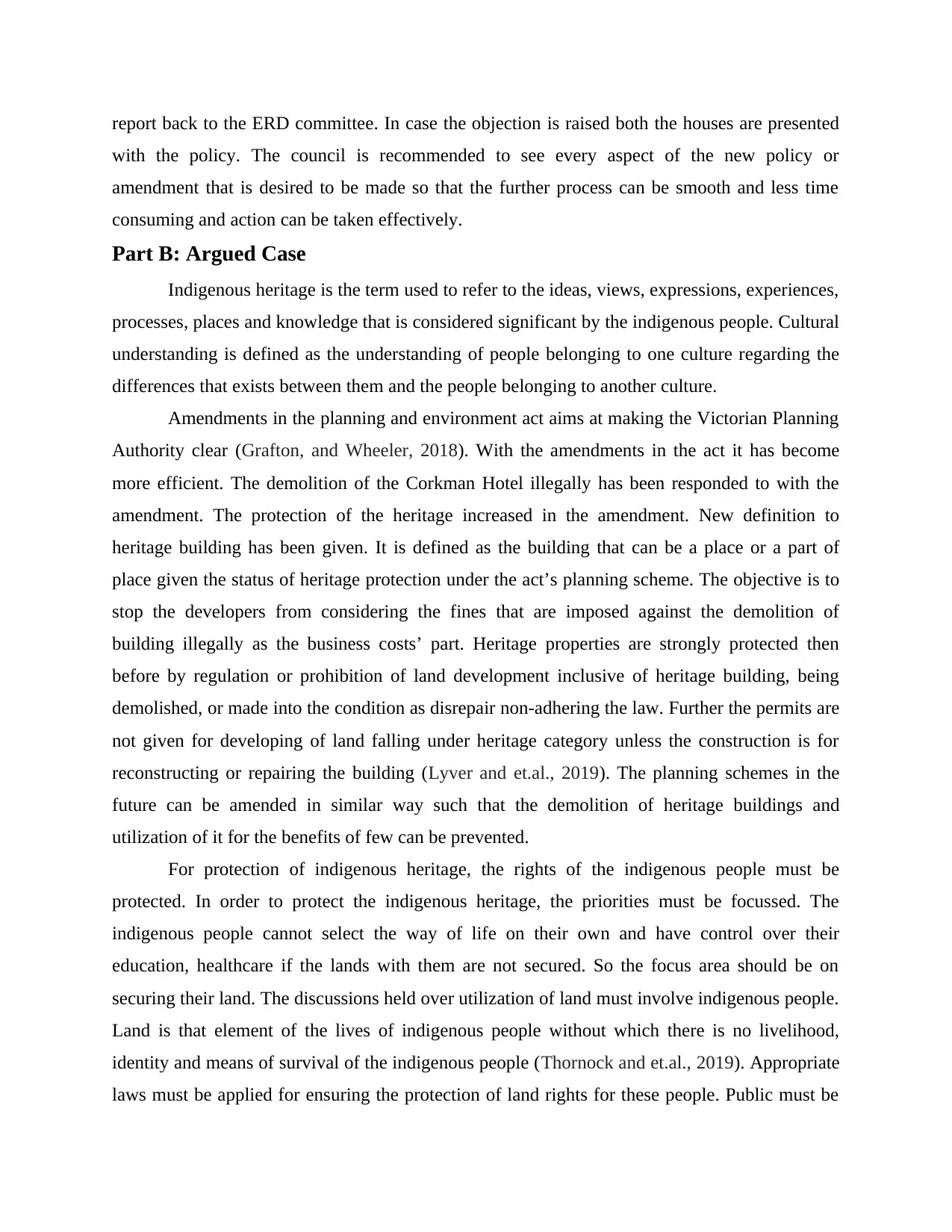
report back to the ERD committee. In case the objection is raised both the houses are presented
with the policy. The council is recommended to see every aspect of the new policy or
amendment that is desired to be made so that the further process can be smooth and less time
consuming and action can be taken effectively.
Part B: Argued Case
Indigenous heritage is the term used to refer to the ideas, views, expressions, experiences,
processes, places and knowledge that is considered significant by the indigenous people. Cultural
understanding is defined as the understanding of people belonging to one culture regarding the
differences that exists between them and the people belonging to another culture.
Amendments in the planning and environment act aims at making the Victorian Planning
Authority clear (Grafton, and Wheeler, 2018). With the amendments in the act it has become
more efficient. The demolition of the Corkman Hotel illegally has been responded to with the
amendment. The protection of the heritage increased in the amendment. New definition to
heritage building has been given. It is defined as the building that can be a place or a part of
place given the status of heritage protection under the act’s planning scheme. The objective is to
stop the developers from considering the fines that are imposed against the demolition of
building illegally as the business costs’ part. Heritage properties are strongly protected then
before by regulation or prohibition of land development inclusive of heritage building, being
demolished, or made into the condition as disrepair non-adhering the law. Further the permits are
not given for developing of land falling under heritage category unless the construction is for
reconstructing or repairing the building (Lyver and et.al., 2019). The planning schemes in the
future can be amended in similar way such that the demolition of heritage buildings and
utilization of it for the benefits of few can be prevented.
For protection of indigenous heritage, the rights of the indigenous people must be
protected. In order to protect the indigenous heritage, the priorities must be focussed. The
indigenous people cannot select the way of life on their own and have control over their
education, healthcare if the lands with them are not secured. So the focus area should be on
securing their land. The discussions held over utilization of land must involve indigenous people.
Land is that element of the lives of indigenous people without which there is no livelihood,
identity and means of survival of the indigenous people (Thornock and et.al., 2019). Appropriate
laws must be applied for ensuring the protection of land rights for these people. Public must be
with the policy. The council is recommended to see every aspect of the new policy or
amendment that is desired to be made so that the further process can be smooth and less time
consuming and action can be taken effectively.
Part B: Argued Case
Indigenous heritage is the term used to refer to the ideas, views, expressions, experiences,
processes, places and knowledge that is considered significant by the indigenous people. Cultural
understanding is defined as the understanding of people belonging to one culture regarding the
differences that exists between them and the people belonging to another culture.
Amendments in the planning and environment act aims at making the Victorian Planning
Authority clear (Grafton, and Wheeler, 2018). With the amendments in the act it has become
more efficient. The demolition of the Corkman Hotel illegally has been responded to with the
amendment. The protection of the heritage increased in the amendment. New definition to
heritage building has been given. It is defined as the building that can be a place or a part of
place given the status of heritage protection under the act’s planning scheme. The objective is to
stop the developers from considering the fines that are imposed against the demolition of
building illegally as the business costs’ part. Heritage properties are strongly protected then
before by regulation or prohibition of land development inclusive of heritage building, being
demolished, or made into the condition as disrepair non-adhering the law. Further the permits are
not given for developing of land falling under heritage category unless the construction is for
reconstructing or repairing the building (Lyver and et.al., 2019). The planning schemes in the
future can be amended in similar way such that the demolition of heritage buildings and
utilization of it for the benefits of few can be prevented.
For protection of indigenous heritage, the rights of the indigenous people must be
protected. In order to protect the indigenous heritage, the priorities must be focussed. The
indigenous people cannot select the way of life on their own and have control over their
education, healthcare if the lands with them are not secured. So the focus area should be on
securing their land. The discussions held over utilization of land must involve indigenous people.
Land is that element of the lives of indigenous people without which there is no livelihood,
identity and means of survival of the indigenous people (Thornock and et.al., 2019). Appropriate
laws must be applied for ensuring the protection of land rights for these people. Public must be
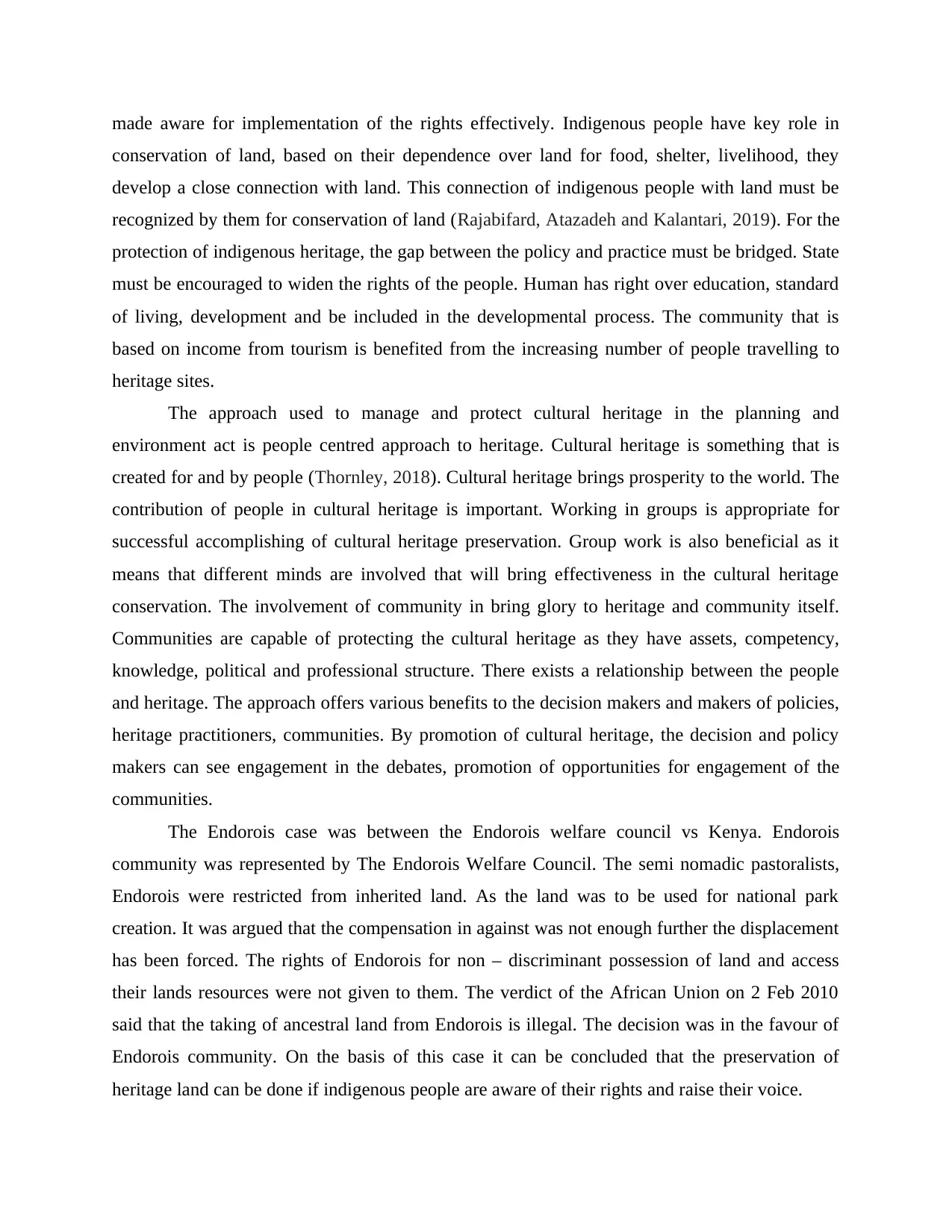
made aware for implementation of the rights effectively. Indigenous people have key role in
conservation of land, based on their dependence over land for food, shelter, livelihood, they
develop a close connection with land. This connection of indigenous people with land must be
recognized by them for conservation of land (Rajabifard, Atazadeh and Kalantari, 2019). For the
protection of indigenous heritage, the gap between the policy and practice must be bridged. State
must be encouraged to widen the rights of the people. Human has right over education, standard
of living, development and be included in the developmental process. The community that is
based on income from tourism is benefited from the increasing number of people travelling to
heritage sites.
The approach used to manage and protect cultural heritage in the planning and
environment act is people centred approach to heritage. Cultural heritage is something that is
created for and by people (Thornley, 2018). Cultural heritage brings prosperity to the world. The
contribution of people in cultural heritage is important. Working in groups is appropriate for
successful accomplishing of cultural heritage preservation. Group work is also beneficial as it
means that different minds are involved that will bring effectiveness in the cultural heritage
conservation. The involvement of community in bring glory to heritage and community itself.
Communities are capable of protecting the cultural heritage as they have assets, competency,
knowledge, political and professional structure. There exists a relationship between the people
and heritage. The approach offers various benefits to the decision makers and makers of policies,
heritage practitioners, communities. By promotion of cultural heritage, the decision and policy
makers can see engagement in the debates, promotion of opportunities for engagement of the
communities.
The Endorois case was between the Endorois welfare council vs Kenya. Endorois
community was represented by The Endorois Welfare Council. The semi nomadic pastoralists,
Endorois were restricted from inherited land. As the land was to be used for national park
creation. It was argued that the compensation in against was not enough further the displacement
has been forced. The rights of Endorois for non – discriminant possession of land and access
their lands resources were not given to them. The verdict of the African Union on 2 Feb 2010
said that the taking of ancestral land from Endorois is illegal. The decision was in the favour of
Endorois community. On the basis of this case it can be concluded that the preservation of
heritage land can be done if indigenous people are aware of their rights and raise their voice.
conservation of land, based on their dependence over land for food, shelter, livelihood, they
develop a close connection with land. This connection of indigenous people with land must be
recognized by them for conservation of land (Rajabifard, Atazadeh and Kalantari, 2019). For the
protection of indigenous heritage, the gap between the policy and practice must be bridged. State
must be encouraged to widen the rights of the people. Human has right over education, standard
of living, development and be included in the developmental process. The community that is
based on income from tourism is benefited from the increasing number of people travelling to
heritage sites.
The approach used to manage and protect cultural heritage in the planning and
environment act is people centred approach to heritage. Cultural heritage is something that is
created for and by people (Thornley, 2018). Cultural heritage brings prosperity to the world. The
contribution of people in cultural heritage is important. Working in groups is appropriate for
successful accomplishing of cultural heritage preservation. Group work is also beneficial as it
means that different minds are involved that will bring effectiveness in the cultural heritage
conservation. The involvement of community in bring glory to heritage and community itself.
Communities are capable of protecting the cultural heritage as they have assets, competency,
knowledge, political and professional structure. There exists a relationship between the people
and heritage. The approach offers various benefits to the decision makers and makers of policies,
heritage practitioners, communities. By promotion of cultural heritage, the decision and policy
makers can see engagement in the debates, promotion of opportunities for engagement of the
communities.
The Endorois case was between the Endorois welfare council vs Kenya. Endorois
community was represented by The Endorois Welfare Council. The semi nomadic pastoralists,
Endorois were restricted from inherited land. As the land was to be used for national park
creation. It was argued that the compensation in against was not enough further the displacement
has been forced. The rights of Endorois for non – discriminant possession of land and access
their lands resources were not given to them. The verdict of the African Union on 2 Feb 2010
said that the taking of ancestral land from Endorois is illegal. The decision was in the favour of
Endorois community. On the basis of this case it can be concluded that the preservation of
heritage land can be done if indigenous people are aware of their rights and raise their voice.
⊘ This is a preview!⊘
Do you want full access?
Subscribe today to unlock all pages.

Trusted by 1+ million students worldwide
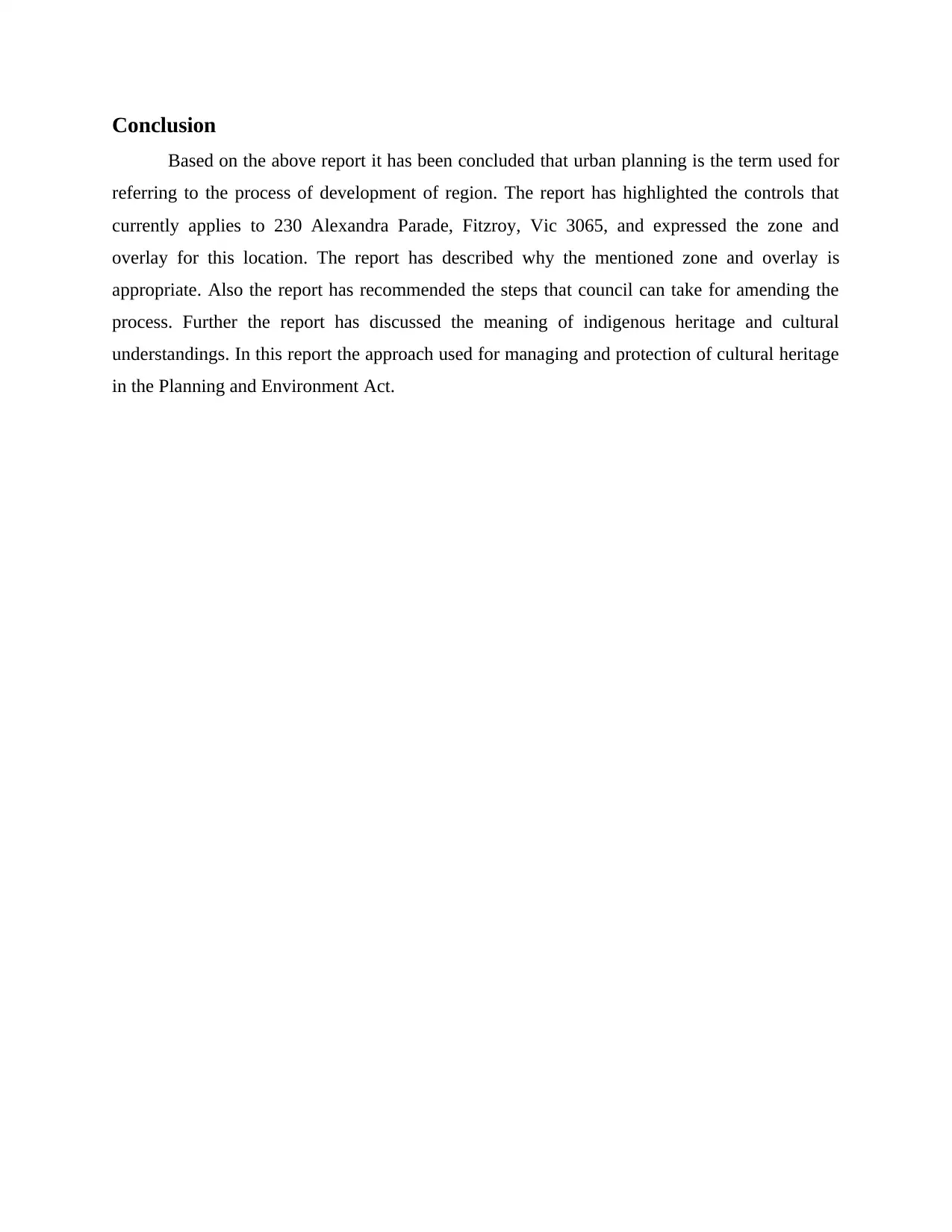
Conclusion
Based on the above report it has been concluded that urban planning is the term used for
referring to the process of development of region. The report has highlighted the controls that
currently applies to 230 Alexandra Parade, Fitzroy, Vic 3065, and expressed the zone and
overlay for this location. The report has described why the mentioned zone and overlay is
appropriate. Also the report has recommended the steps that council can take for amending the
process. Further the report has discussed the meaning of indigenous heritage and cultural
understandings. In this report the approach used for managing and protection of cultural heritage
in the Planning and Environment Act.
Based on the above report it has been concluded that urban planning is the term used for
referring to the process of development of region. The report has highlighted the controls that
currently applies to 230 Alexandra Parade, Fitzroy, Vic 3065, and expressed the zone and
overlay for this location. The report has described why the mentioned zone and overlay is
appropriate. Also the report has recommended the steps that council can take for amending the
process. Further the report has discussed the meaning of indigenous heritage and cultural
understandings. In this report the approach used for managing and protection of cultural heritage
in the Planning and Environment Act.
Paraphrase This Document
Need a fresh take? Get an instant paraphrase of this document with our AI Paraphraser
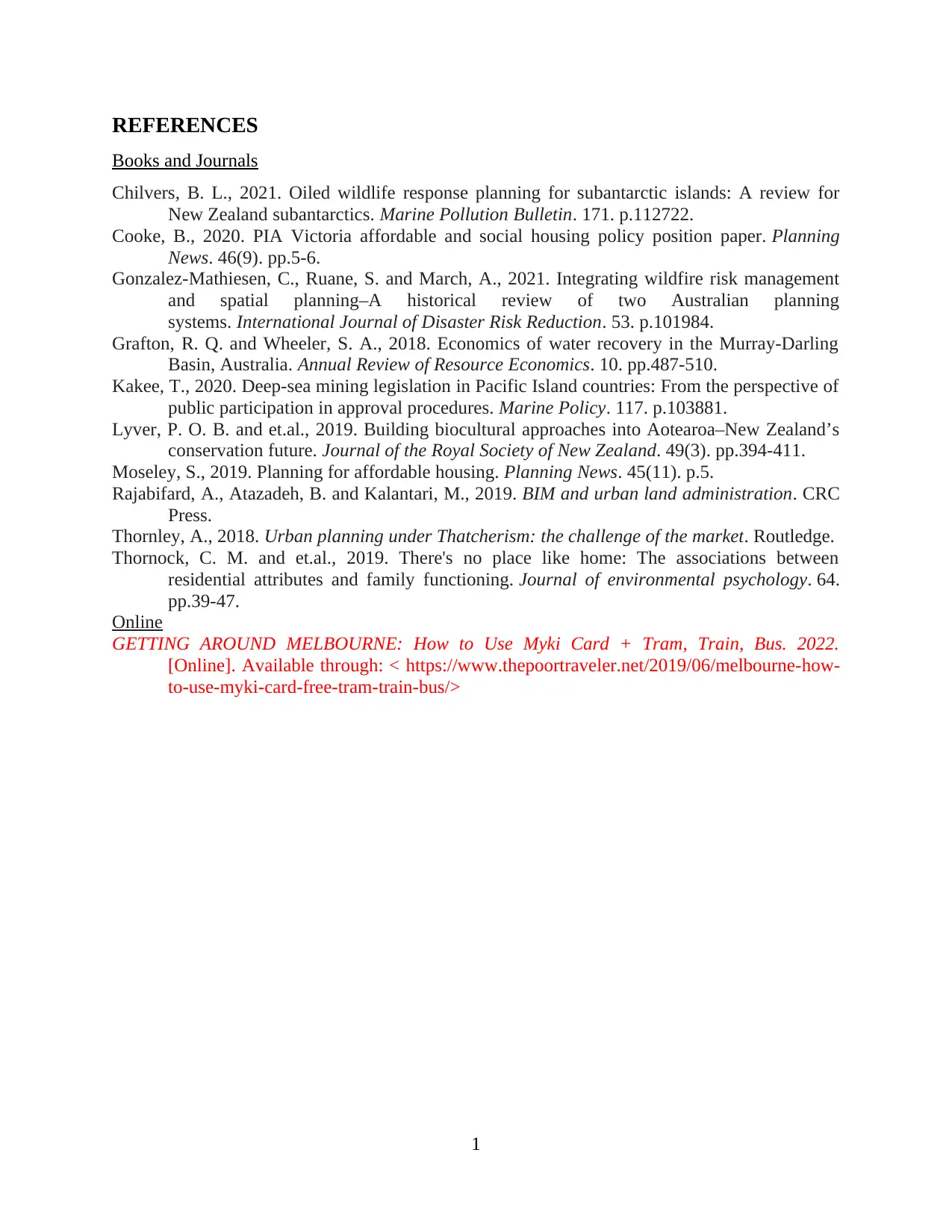
REFERENCES
Books and Journals
Chilvers, B. L., 2021. Oiled wildlife response planning for subantarctic islands: A review for
New Zealand subantarctics. Marine Pollution Bulletin. 171. p.112722.
Cooke, B., 2020. PIA Victoria affordable and social housing policy position paper. Planning
News. 46(9). pp.5-6.
Gonzalez-Mathiesen, C., Ruane, S. and March, A., 2021. Integrating wildfire risk management
and spatial planning–A historical review of two Australian planning
systems. International Journal of Disaster Risk Reduction. 53. p.101984.
Grafton, R. Q. and Wheeler, S. A., 2018. Economics of water recovery in the Murray-Darling
Basin, Australia. Annual Review of Resource Economics. 10. pp.487-510.
Kakee, T., 2020. Deep-sea mining legislation in Pacific Island countries: From the perspective of
public participation in approval procedures. Marine Policy. 117. p.103881.
Lyver, P. O. B. and et.al., 2019. Building biocultural approaches into Aotearoa–New Zealand’s
conservation future. Journal of the Royal Society of New Zealand. 49(3). pp.394-411.
Moseley, S., 2019. Planning for affordable housing. Planning News. 45(11). p.5.
Rajabifard, A., Atazadeh, B. and Kalantari, M., 2019. BIM and urban land administration. CRC
Press.
Thornley, A., 2018. Urban planning under Thatcherism: the challenge of the market. Routledge.
Thornock, C. M. and et.al., 2019. There's no place like home: The associations between
residential attributes and family functioning. Journal of environmental psychology. 64.
pp.39-47.
Online
GETTING AROUND MELBOURNE: How to Use Myki Card + Tram, Train, Bus. 2022.
[Online]. Available through: < https://www.thepoortraveler.net/2019/06/melbourne-how-
to-use-myki-card-free-tram-train-bus/>
1
Books and Journals
Chilvers, B. L., 2021. Oiled wildlife response planning for subantarctic islands: A review for
New Zealand subantarctics. Marine Pollution Bulletin. 171. p.112722.
Cooke, B., 2020. PIA Victoria affordable and social housing policy position paper. Planning
News. 46(9). pp.5-6.
Gonzalez-Mathiesen, C., Ruane, S. and March, A., 2021. Integrating wildfire risk management
and spatial planning–A historical review of two Australian planning
systems. International Journal of Disaster Risk Reduction. 53. p.101984.
Grafton, R. Q. and Wheeler, S. A., 2018. Economics of water recovery in the Murray-Darling
Basin, Australia. Annual Review of Resource Economics. 10. pp.487-510.
Kakee, T., 2020. Deep-sea mining legislation in Pacific Island countries: From the perspective of
public participation in approval procedures. Marine Policy. 117. p.103881.
Lyver, P. O. B. and et.al., 2019. Building biocultural approaches into Aotearoa–New Zealand’s
conservation future. Journal of the Royal Society of New Zealand. 49(3). pp.394-411.
Moseley, S., 2019. Planning for affordable housing. Planning News. 45(11). p.5.
Rajabifard, A., Atazadeh, B. and Kalantari, M., 2019. BIM and urban land administration. CRC
Press.
Thornley, A., 2018. Urban planning under Thatcherism: the challenge of the market. Routledge.
Thornock, C. M. and et.al., 2019. There's no place like home: The associations between
residential attributes and family functioning. Journal of environmental psychology. 64.
pp.39-47.
Online
GETTING AROUND MELBOURNE: How to Use Myki Card + Tram, Train, Bus. 2022.
[Online]. Available through: < https://www.thepoortraveler.net/2019/06/melbourne-how-
to-use-myki-card-free-tram-train-bus/>
1
1 out of 8
Related Documents
Your All-in-One AI-Powered Toolkit for Academic Success.
+13062052269
info@desklib.com
Available 24*7 on WhatsApp / Email
![[object Object]](/_next/static/media/star-bottom.7253800d.svg)
Unlock your academic potential
Copyright © 2020–2025 A2Z Services. All Rights Reserved. Developed and managed by ZUCOL.



